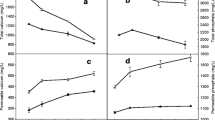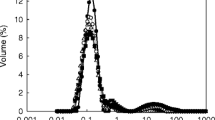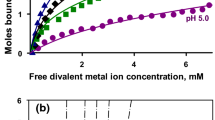Abstract
By modifying the forces (hydrophobic and electrostatic interactions, hydrogen bonding and presence of micellar calcium phosphate) responsible for the structure and the stability of casein micelles, alkalinisation induces a disruption of casein micelles in milk. The objective of this work was to compare the alkalinisation-induced physico-chemical changes of casein micelles of buffalo and cow milks with a special attention to the mineral fraction. The whiteness and viscosity were determined as global characteristics of milk. The aqueous and micellar phases of milks were ascertained for the distributions of the concentrations of nitrogen, casein molecules, calcium, inorganic phosphate and water as their supramolecular and molecular characteristics. These parameters were measured at six pH values between pH 6.7 and 10.8. Between pH 6.7 and 10.8, the whiteness decreased from 73.5 to 50.9 and from 71.3 to 50.9 units and the viscosity increased from 1.8 to 10.2 and from 1.5 to 4.8 mPa·s for buffalo and cow milks, respectively. Simultaneously, > 90% of nitrogen contents were in the supernatants of ultracentrifugation at pH 9.7 and 8.6 for buffalo and cow milks, respectively. Chromatographic analyses showed that caseins were totally solubilised at these pH values. Calcium and inorganic phosphate concentrations progressively increased in the supernatants of ultracentrifugation and decreased in the ultrafiltrates. At alkaline pH, the negative charge of caseins increased and the inorganic phosphate ion changed its ionisation state from HPO4 2− to PO4 3− form. This form has a greater affinity for calcium and can demineralise casein micelles. The consequences were modifications of protein-protein and protein-minerals interactions resulting in micellar disruption. The dissociations took place at pH 9.7 and 8.6 for buffalo and cow milks, respectively. These differences were due to higher concentrations of casein and minerals in buffalo than in cow milk, which were also our criteria of selection of the former as a model.
Abstract
pH 6.7–10.8 (6 pH) pH 6.7–10.8, 73.5 50.9 71.3 50.9 1.8 mPa·s 10.2 mPa·s, 1.5 mPa·s 4.8 mPa·s pH 9.7 pH 8.6 90% pH pH HPO4 2− PO4 3− PO4 3− pH 9.7 pH 8.6 pH
Résumé
En modifiant les forces qui interviennent dans la structure et la stabilité des micelles de caséines (interactions hydrophobes et électrostatiques, liaisons hydrogène et présence de phosphate de calcium micellaire), l’alcalinisation du lait induit une dissociation des micelles de caséines. L’objectif de ce travail était de comparer les changements physico-chimiques et particulièrement la fraction minérale des micelles de caséines induits par l’alcalinisation de laits de bufflesse et de vache. La blancheur et la viscosité étaient déterminées comme caractéristiques globales du lait. Les distributions entre phases aqueuses et micellaires des concentrations en azote, molécules de caséines, calcium, phosphate inorganique et eau étaient déterminées comme caractéristiques supramoléculaires et moléculaires. Ces paramètres étaient mesurés à six valeurs de pH compris entre pH 6,7 et 10,8. Entre pH 6,7 et 10,8, la blancheur diminuait de 73,5 à 50,9 et de 71,3 à 50,9 unités alors que la viscosité augmentait de 1,8 à 10,2 et de 1,5 à 4,8 mPa·s pour les laits de bufflesse et de vache, respectivement. Dans le même temps, plus de 90 % des concentrations en azote étaient dans les surnageants d’ultracentrifugation des laits de bufflesse et de vache à pH 9,7 et 8,6, respectivement. Les analyses chromatographiques ont montré que les caséines étaient totalement solubilisées à ces valeurs de pH. Les concentrations de calcium et de phosphate inorganique augmentaient progressivement dans les surnageants d’ultracentrifugation et diminuaient dans les ultrafiltrates. À pH alcalin, la charge négative des caséines augmente et l’ion phosphate change son état d’ionisation en passant de la forme HPO4 2− à la forme PO4 3−. Cette forme a une forte affinité pour le calcium et peut déminéraliser les micelles de caséines. Les conséquences étaient des modifications dans les interactions protéines-protéines et protéines-minéraux conduisant à une dissociation micellaire. Les dissociations étaient respectivement atteintes à pH 9,7 et 8,6 pour les laits de bufflesse et de vache. Ces différences quantitatives étaient dues aux plus fortes concentrations de caséines et de minéraux dans le lait de bufflesse par rapport au lait de vache, ce qui correspondait à nos critères de choix de ce lait comme modèle.
Similar content being viewed by others
References
Ahmad S., Gaucher I., Rousseau F., Beaucher E., Piot M., Grongnet J.F., Gaucheron F., Effects of acidification on physico-chemical characteristics of buffalo milk: a comparison with cow’s milk, Food Chem. 106 (2008) 11–17.
Gaucheron F., Le Graët Y., Piot M., Boyaval E., Determination of anions of milk by ion chromatography, Lait 76 (1996) 433–443.
Griffin M.C.A., Griffin W.C., A simple turbidimetric method for the determination of the refractive index of large colloidal particles applied to casein micelles, J. Colloidal Interface Sci. 104 (1985) 409–415.
Grufferty M.B., Fox P.F., Effect of added NaCl on some physico-chemical properties of milk, Ir. J. Food Sci. Technol. 9 (1985) 1–9.
Huppertz T., Fox P.F., Effect of NaCl on some physico-chemical properties of concentrated bovine milk, Int. Dairy J. 16 (2006) 1142–1148.
Huppertz T., Vaia B., Smiddy M.A., Reformation of casein particles from alkalinedisrupted casein micelles, J. Dairy Res. 75 (2008) 44–47.
International Dairy Federation, Détermination de la teneur en caséine du lait, International Standard FIL-IDF n∘ 29, 1964.
International Dairy Federation, Détermination de la teneur en azote, 4. Détermination de la teneur en azote non protéique, International Standard, FIL-IDF n∘ 20B, 1993.
Jaubert A., Martin P., Reverse-phase HPLC analysis of goat caseins: identification of αS1 and αS2 genetic variants, Lait 72 (1992) 235–247.
Karman A.H., Van Boekel M.A.J.S., Evaluation of the Kjeldahl factor for conversion of the nitrogen content of milk and milk products to protein content, Neth. Milk Dairy J. 40 (1986) 315–336.
Kneifel W., Ulberth F., Schaffer E., Tristimulus colour reflectance measurement of milk and dairy products, Lait 72 (1992) 383–391.
Korolczuk J., Maubois J.-L., Loheac J., Suivi de la coagulation-présure du lait à l’aide d’un nouveau capteur réfractométrique, Lait 66 (1986) 327–339.
Le Graët Y., Brulé G., Effects of pH and ionic strength on distribution of mineral salts in milk, Lait 73 (1993) 51–60.
Odagiri S., Nickerson T.A., Micellar changes in skim milk treated with alkali or acid, J. Dairy Sci. 48 (1965) 1157–1160.
Pellegrino L., Noni I.D., Tirelli A., Resmini P., Determinazione de latte di vacca nei fromaggi di speceie minori mediante HPLC delle sieroproteine, nota 1, Applicazione alla mozzarella di bufala, Sci. Tec. Latt. Casearia 42 (1991) 87–101.
Petrilli P., Chianese L., Addeo F., Buffalo αs0-casein: isolation and characterization, J. Dairy Res. 46 (1979) 231–233.
Pierre A., Brulé G., Mineral and protein equilibria between the colloidal and soluble phases of milk at low temperature, J. Dairy Res. 48 (1981) 417–428.
Plomley K.E., Higgins H.G., Hayes I.F., Spontaneous gelation of alkaline casein dispersions, Nature 167 (1951) 224.
Rose D., Relation between micellar and serum casein in bovine milk, J. Dairy Sci. 51 (1968) 1897–1902.
Vaia B., Smiddy M.A., Kelly A.L., Huppertz T., Solvent-mediated disruption of bovine casein micelles at alkaline pH, J. Agric. Food Chem. 54 (2006) 8288–8293.
Van Dijk H.J.M., The properties of casein micelles. 4. The effects of the addition of NaCl, MgCl2 or NaOH on the partition of Ca, Mg and PO4 in cow’s milk, Neth. Milk Dairy J. 45 (1991) 241–251.
Van Dijk H.J.M., The properties of casein micelles. 5. The determination of heat-induced calcium phosphate precipitations in milk, Neth. Milk Dairy J. 46 (1992) 69–76.
Van Dijk H.J.M., The properties of casein micelles. 6. Behaviour above pH 9, and implication for the micelle model, Neth. Milk Dairy J. 46 (1992) 101–103.
Walstra P., On the stability of casein micelles, J. Dairy. Sci. 73 (1990) 1965–1979.
Walstra P., Jenness R., Dairy Chemistry and Physics, John Wiley & Sons, New York, USA, 1984.
Zicarelli L., Buffalo milk: its properties, dairy yield and mozzarella production, Vet. Res. Comm. 28 (2004) 127–135.
Author information
Authors and Affiliations
Corresponding author
About this article
Cite this article
Ahmad, S., Piot, M., Rousseau, F. et al. Physico-chemical changes in casein micelles of buffalo and cow milks as a function of alkalinisation. Dairy Sci. Technol. 89, 387–403 (2009). https://doi.org/10.1051/dst/2009020
Received:
Accepted:
Issue Date:
DOI: https://doi.org/10.1051/dst/2009020




